Mae Kampong Village Travel Guide 2025
Mae Kampong is a mountain village nestled at around 1,000 meters above sea level, surrounded by thickly wooded hills. It’s not the place for sweeping views of rice paddies that many associate with Thailand; instead, it’s a village that wraps you in a canopy of green, with misty mornings and crisp mountain air. Contrary to some guidebooks claiming it’s 1,300 meters above sea level, the highest point in the village itself is Rabeing View Cafe, located at 1,082 meters. This spot offers one of the best views of the village, and there’s something magical about enjoying a drink while gazing out over the rooftops and hills below.
What You Need to Know First
Location: Huai Kaeo (Thai: ห้วยแก้ว, hûuay gâew ), Mae On District (Thai: แม่ออน, mâe-on), Chiang Mai (Thai: เชียงใหม่, chiiang-mài)
Population: ~120 families
Cultivated crops: tea, coffee
Latitude: 99.351534
Longitude: 18.865693
Altitude: 1033 meters (3323 feet)
GPS coordinates: 18°51’56.5″N, 99°21’05.5″E
The history of Mae Kampong village dates back around 100 years, when farmers from the Doi Saket area first settled here. Today, the village thrives on ecotourism, tea cultivation, and coffee growing as its main sources of income. A visit to the scenic Mae Kampong village offers the chance to immerse yourself in its unique culture and traditions. Get ready for an unforgettable experience in this charming, nature-rich village!

The nearby Mae Kampong Waterfall is located at around 1,100 meters above sea level. Although it doesn’t have an observation deck, the waterfall is a modest yet refreshing stop. A mountain stream flows from here, winding its way down through the heart of the village, providing a soothing soundtrack to any stroll.
If you’re up for a short drive — roughly 3 kilometers uphill from the village — you’ll find Kew Fin Viewpoint, located on the border of Chiang Mai and Lampang provinces, sitting at approximately 1,506 meters above sea level. It offers breathtaking views of the rolling mountains and densely forested hills that stretch into the distance. It’s the kind of view that makes you pause and take a deep breath, letting the cool mountain breeze remind you of why you came here in the first place.
Traveler Tips: Start your village exploration in the early morning when the air is fresh, and the village begins to come alive. Wear comfortable walking shoes, as the paths can be uneven and steep in some areas. Don’t forget your camera — the views here are stunning, and you’ll want to capture every moment. Make time to interact with the local villagers as well; they are often happy to share stories about their culture and traditions, adding a personal touch to your visit.
All year round, a tranquil, rustic atmosphere, delicious food, and fantastic weather saving you from the scorching and exhausting Thai sun – all this you will find in Baan Mae Kampong. If you stay here overnight in the guest house, you can also enjoy the night sounds of the wildlife and the murmuring of the mountain stream. Some travelers find it very soothing and help relieve mental fatigue and tension.
Nestled in the lush mountains east of Chiang Mai, Mae Kampong is a peaceful village known for its cool climate, traditional wooden houses, and organic coffee farms. While the village itself is walkable, getting there is tricky without your own transport. Renting a car in Chiang Mai allows you to explore nearby waterfalls, tea plantations, and mountain viewpoints with ease. Discover the best car rental options in Chiang Mai.
What To Do In Mae Kampong
Wat Khantha Pruksa
This is not the first attraction you encounter as you enter the village, but it is the first place you will most likely have to stop. The reason is simple enough – there is a large parking lot for 20 cars, which you won’t find anywhere else in the village. So the first thing to do is to go there, leave your motorcycle or car in the parking lot and then explore the town and its surroundings on foot, slowly enjoying nature and the clean air.
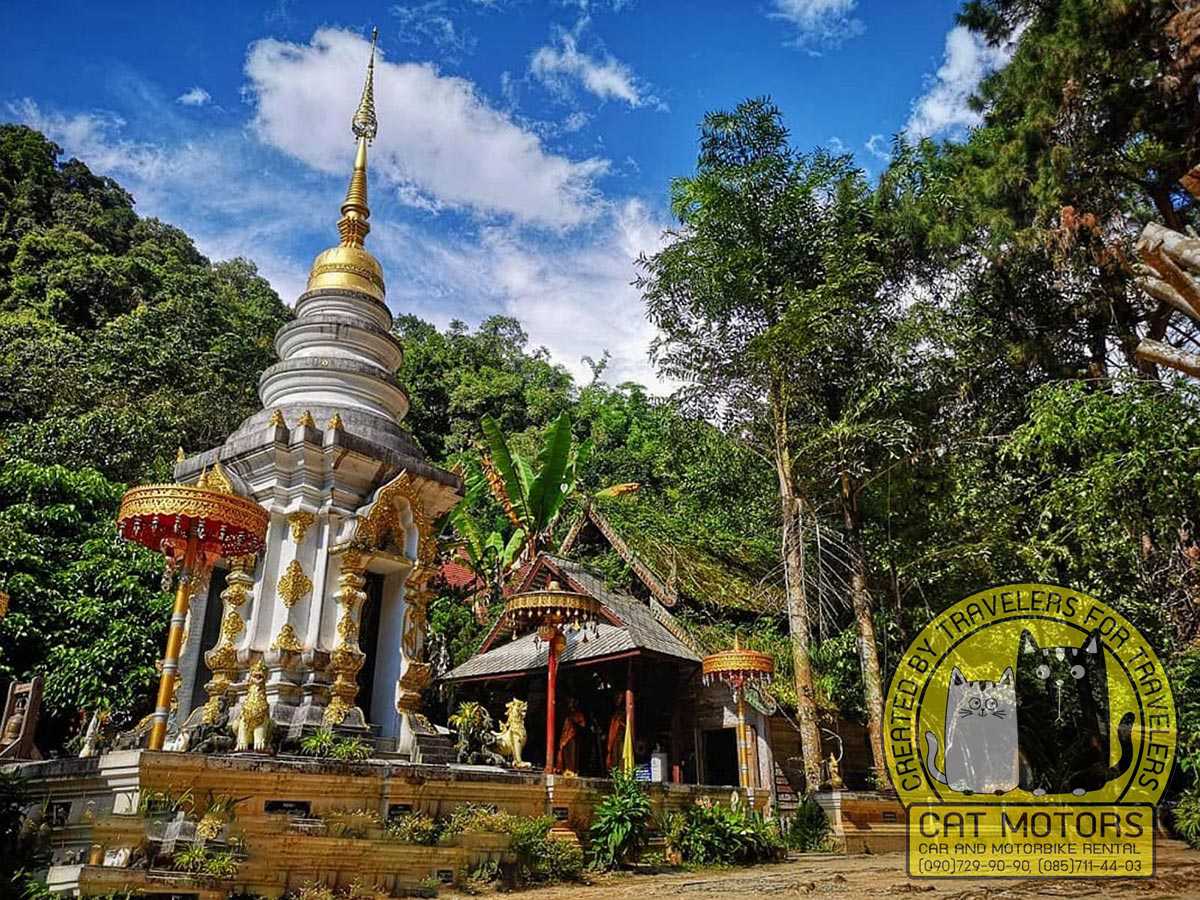
Wat Mae Kampong (also known as Wat Khantha Pruksa), a Buddhist temple built more than 90 years ago in 1930, is the only temple in Mae Kampong. The temple’s viharn is made of golden teak wood with exquisite patterns created by local architects. The roof of the viharn is also made of teak but is covered with green moss, indicating the high humidity of the local climate and cool temperatures throughout the year.
The temple’s highlight is a Buddhist Ubosot located in the middle of the Mae Kampong stream running through the village. There are only two Buddhist Wats in Chiang Mai Province whose Ubosots are situated in the middle of the water. Wat Mae Kampong and Wat Phutta En at Mae Chaem sub-district (Mae Chaem is a part of the Mae Hong Son loop)
Mae Kampong Waterfall
After spending time at the cafe, you can walk about 400 meters up the road to Mae Kampong Waterfall (Thai: น้ำตกแม่กำปอง, náam dtòk mâe-gam-bpong, namtok mae kampong). You can see this little waterfall right from the road. You don’t have to go off the main road or up somewhere very long like the falls of Doi Intanon or Khun Korn waterfall in Chiang Rai, where you have to walk about half an hour on a narrow path among the jungle.
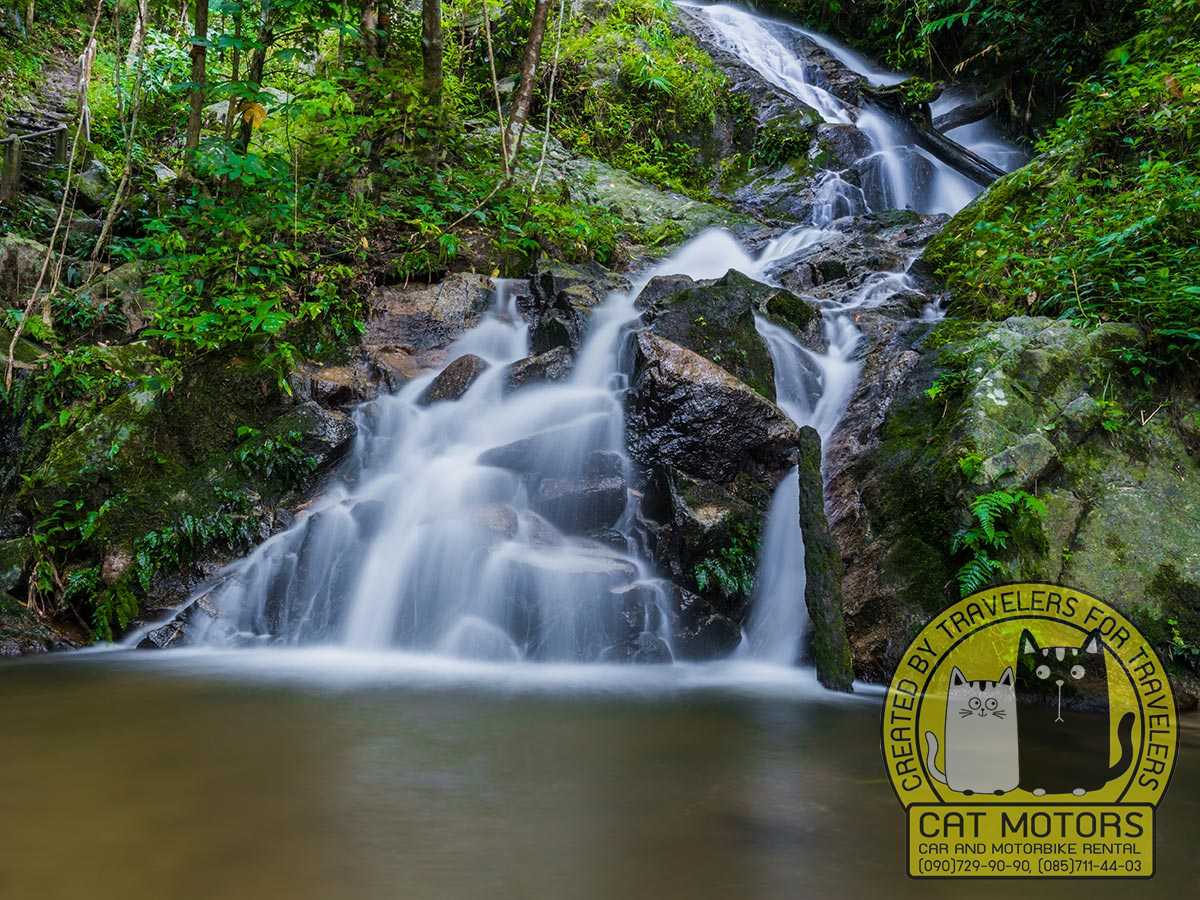
From the temple to the waterfall is only a short walk. Also, there is a parking lot for seven cars. You can try to get to this place by car, but if you come to the village on days when it is crowded, these parking spaces may be occupied by other travelers.
If you decide to wander around, there is a wildlife exploration trail next to the waterfall. You can also hike up to the top to see all seven tiers of the falls. On your way up, you’ll discover a bush of different varieties of ferns, and at the top there’s a small natural pool where you can swim.
Kew Fin Viewpoint
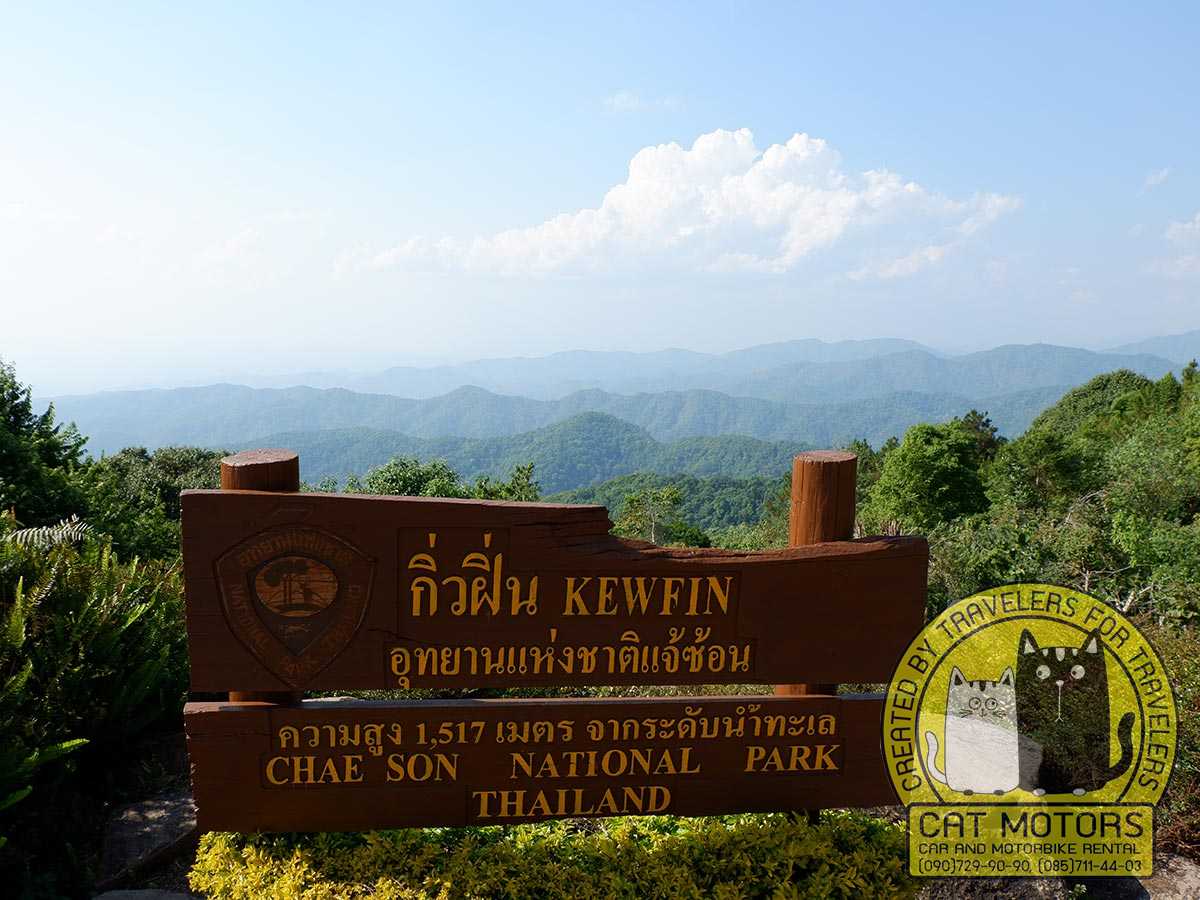
When you get to this viewpoint, you will find yourself on a beautiful mountain top with a magnificent view of the surroundings of Chiang Mai province, where you can take photos for your Instagram.
Legend has it that in the old days, when the opium trade flourished in the region, this was a meeting place for opium sellers and buyers.
It’s a beautiful view over the surrounding mountains. Don’t forget your sweater; this place is windy and breeze. If you stay overnight at Mae Kampong, coming here to see the sunrise is a Must Do. Ask your homestay hosts about transport up to here from the village the day before as we had to wake early at 4.30 am! It gets crowded during the incredible high season so that photography enthusiasts may choose their strategic spots in advance. Otherwise, relax and enjoy the million-dollar views here! Recommended!
By the way, don’t forget to read our article about the best Muay Thai gyms in Chiang Mai.
Flight Of The Gibbon
The Flight of the Gibbon was created in 2007 by New Zealand adventure sports enthusiast David Allardice. This attraction is Thailand’s first zip-line ride through the jungle, with bases located at the tops of giant trees, some up to 60-70 meters high.
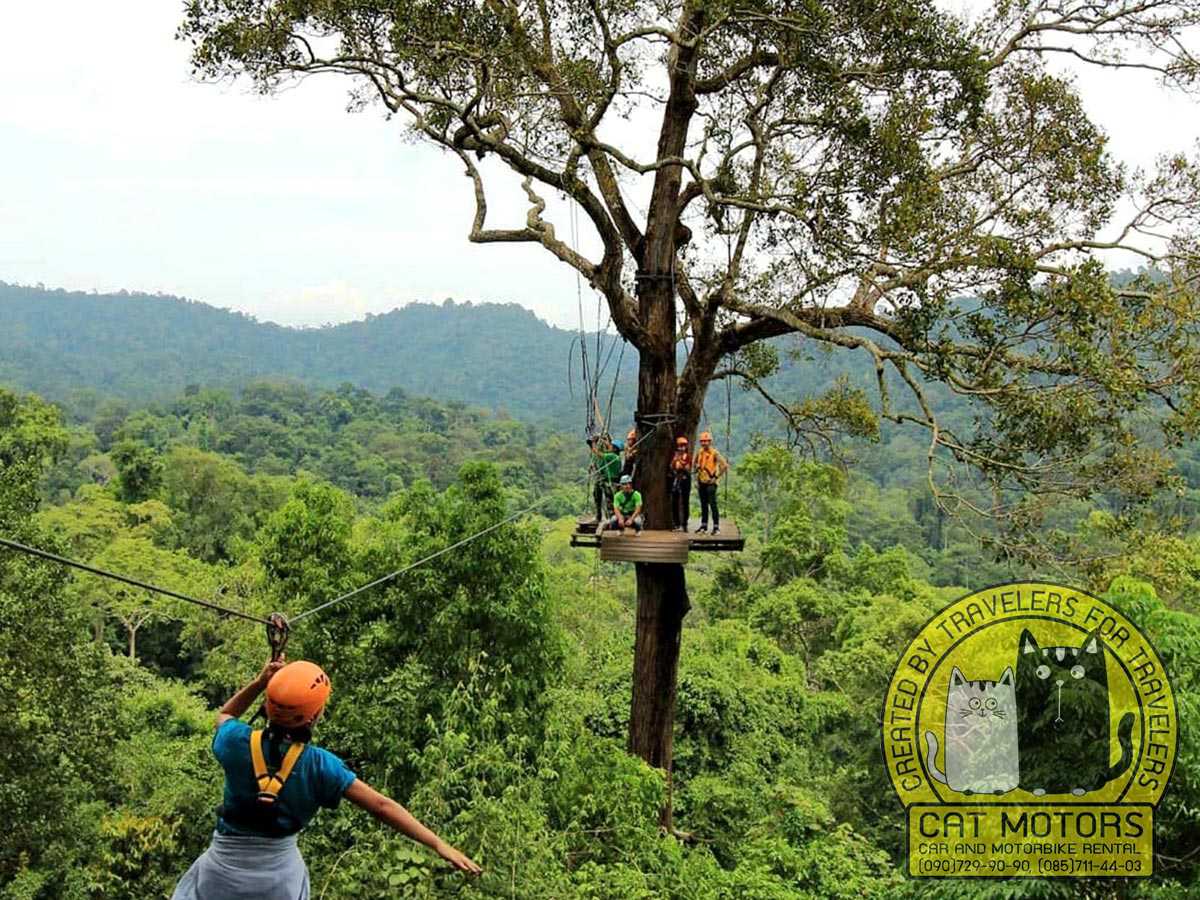
Have you ever tried walking over a swinging narrow suspension bridge at this height? It is breathtaking and unforgettable! It also takes courage to get over all the base stations by sliding on the zip line. Fear not – there are safety ropes.
Ensure you have a helmet, leather/suede gloves (if you use your hand for braking), and that the track has a good safety record. Professional zip-lines often have double ropes, ensuring that the other will continue to hold the visitor if one cord is compromised. It is also essential to follow all safety instructions given during training and report any health problems to the guides.
Some travel insurers may consider zip-lining a dangerous activity and may require special coverage at an additional cost. However, zip-lining is generally considered a safe activity. Injuries are rare and fatal accidents are even more infrequent.
In addition to being a recreational activity, Flight of the Gibbon also focuses on wildlife and gibbon conservation, mangrove reforestation, community outreach, and eco-tourism to help villagers and support underprivileged families in the area.
Exploring Mae Kampong’s Culinary Delights
Mae Kampong is not just about breathtaking views and cool mountain breezes; it’s also a place that invites you to slow down and savor life through its charming café culture. From panoramic vistas to treehouse escapes, each café here offers something unique — a sense of connection to nature, a taste of local flavors, and an opportunity to relax in serene settings. Whether you are looking to start your morning with a stunning sunrise over the hills, enjoy a relaxing afternoon by a waterfall, or take in a picturesque sunset, Mae Kampong’s cafes provide the perfect backdrop for each moment. Let’s take a closer look at some of the best spots to grab a bite, have a drink, and experience the enchanting atmosphere of this beautiful mountain village.
A culinary highlight of Mae Kampong is its local delicacy — fermented Miang tea leaves (ใบเมี่ยง), made from the Assam tea tree (Camellia sinensis var. assamica), commonly grown in northern Thailand. Miang has been part of the traditional culture of northern Thailand for centuries. The tea leaves are picked in bunches and then steamed in bamboo baskets to soften them. After steaming, the leaves are left to ferment for one to three weeks, depending on the desired flavor and texture. The resulting product has a slightly sour and tangy taste, which is both unique and refreshing.
Miang is typically enjoyed as a fermented tea leaf snack, often paired with condiments like pickled garlic or eaten with salt to enhance its tangy flavor. However, there is also a popular dish called Miang Kham, which uses chaplu leaves (Piper sarmentosum), distinct from the fermented tea leaves used in Miang. Miang Kham is a traditional Thai snack involving various flavorful fillings wrapped in chaplu leaves. In Miang Kham, ingredients like ginger, shallots, lime, toasted coconut, peanuts, and sometimes chili are wrapped in these leaves. This combination delivers a mix of flavors — tangy, spicy, sweet, and salty — creating a burst of textures in every bite. Miang can also be enjoyed in simpler forms, paired with pickled garlic or other local кcondiments.
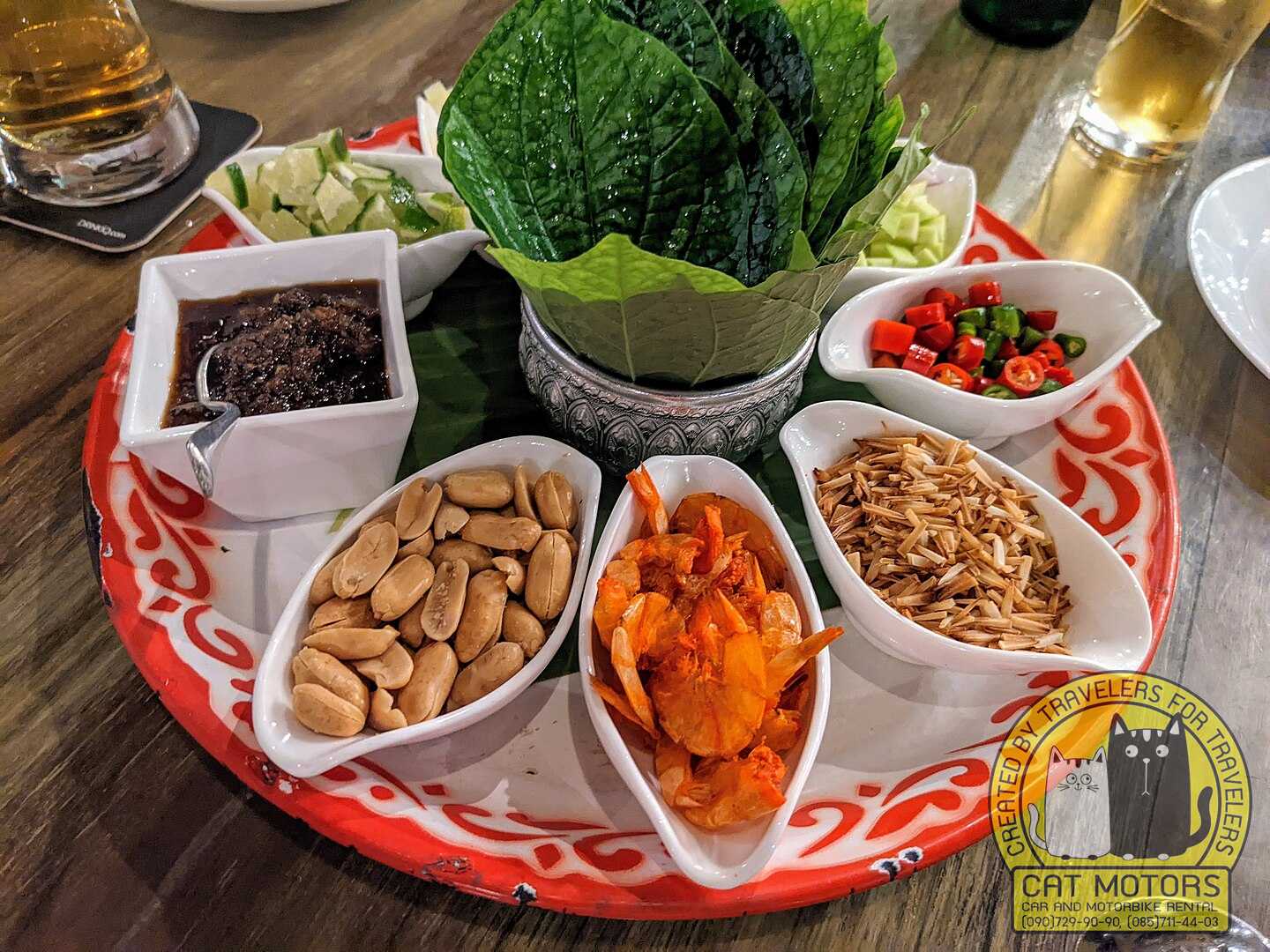
Traditional Local Dishes of Mae Kampong
Staying in Mae Kampong isn’t just about the scenery – it’s also a culinary journey through Northern Thailand’s traditions. The village is famed for a few local specialties and classic dishes, often made from freshly harvested ingredients. Here are some must-try traditional foods, their significance, and where to find them:
Miang (Fermented Tea Leaf Snacks) – The Village’s Heritage Delicacy
Mae Kampong has a centuries-old tradition of producing miang, fermented Assam tea leaves. These tea leaves are pickled through a long fermentation (often months), which removes bitterness and yields a uniquely tart, earthy leaf. Locals often chew miang plain as a pick-me-up or prepare it as a snack by wrapping the fermented leaves around a mixture of sweet grated coconut, peanuts, palm sugar, and a hint of salt to balance flavors. Another popular preparation includes wrapping miang leaves around shallots, peanuts, grated coconut, and sometimes chilies.
Significance: Miang was once a main source of income for the village and is a symbol of Northern Thai hospitality, often served to guests.
Where to try: Homestays often serve miang with afternoon tea. You can also sample it at local eateries. Consider asking to try leaves fermented for different lengths of time to appreciate the variety in flavor.
Khao Soi (Northern Curry Noodles)
Khao Soi is a coconut-milk-based curry noodle dish beloved across Northern Thailand, including Mae Kampong. It features soft egg noodles in a coconut curry broth, topped with crispy noodles. The curry is flavored with aromatic spices and often includes tender chicken.
Significance: This dish reflects the Lanna (Northern Thai) and Burmese cultural influence in the region. It’s a hearty meal perfect for the cooler mountain climate.
Where to try: Mae Kampong’s street food stalls typically serve khao soi around lunchtime.
Sai Ua (Northern Thai Grilled Sausage)
Sai Ua, sometimes called Chiang Mai sausage, is a grilled pork sausage packed with aromatic herbs and spices. The minced pork is mixed with lemongrass, kaffir lime leaf, galangal, garlic, chilies, and a bit of lime zest, resulting in a flavorful, spicy sausage.
Significance: Sai Ua showcases the local preference for bold, herbal flavors. It’s often homemade, highlighting family recipes passed through generations.
Where to try: Look for sai ua grilling on carts or at the Mae Kampong street market in the evenings. It’s delicious with sticky rice or enjoyed alone as a snack.
Other Northern Thai Staples
Mae Kampong’s street food, while limited, offers authentic Northern Thai flavors. Look for grilled meats such as chicken wings, pork skewers, and made-to-order papaya salad (som tam). In the mornings, vendors may offer warm sticky rice topped with egg custard or grilled bananas wrapped in sticky rice.
Where to try: Head to the village center in the late afternoon or early evening when locals set up food stalls. The street food here provides a tasty insight into local life, as villagers gather to enjoy meals and socialize.
Local Cafes and Coffee Shops
⚠️ Important Note: Mae Kampong is a super popular village now. There are tourists all year round, even when it rains all day. Because of this, many local cafes have stopped caring: you might wait ages for your order, the food is so-so and overpriced, the coffee is sour, and the staff can be rude. If you’re unhappy, they don’t care — there’s always another tourist.
Always check recent reviews on real platforms like Google Maps, TripAdvisor, or Wongnai. Even the most basic places in Thailand rarely score below 4.2. If you see a lower rating, that’s a big red flag.
Be careful if a cafe’s Facebook page only shows good comments on posts but has reviews disabled — that usually means the owners delete criticism and block unhappy customers. If this matches a low rating on Google Maps, TripAdvisor, or Wongnai, just avoid that place, no matter how “Instagram-famous” it is. Don’t fall for the hype: nice photos online are just bait for tourists and don’t guarantee good food or service. We only recommend places that have stood the test of time and that you can really trust.
Ing Dao Mae Kampong
Best time: Early morning, 6:00 – 8:00
Ing Dao Mae Kampong is one of those places that feels like a secret tucked away in the mountains — a small, unassuming café that offers sweeping panoramic views of the entire Mae Kampong village. Perched up on a hill, this café invites you to sit on the edge of the terrace, sipping freshly squeezed juice while the morning mist slowly dissolves, revealing the lush green slopes. Imagine the tranquility — the world waking up around you, the chill morning breeze, and that sense of magic that only early hours in a mountain village can provide. Come early, and you’ll be rewarded with silence, broken only by the rustle of leaves and distant birdsong.
Traveler Tips: Bring a warm jacket, as early mornings in Mae Kampong can be quite chilly, especially up in the hills. Don’t forget your camera — the views are simply stunning, especially in the morning light. Winter mornings come with a magical mist, making this an ideal spot for a warm tea or hot chocolate. In summer, fresh juices are perfect for cooling down.
Café In The Doi
Best time: Early morning, 6:30 – 9:00
Café In The Doi location
Café In The Doi is a scenic haven, filled with whimsical photo opportunities. There’s a white staircase leading to the sky, a cozy bird’s nest that fits two, and plenty of other picturesque spots that make it a favorite for Instagram enthusiasts. The café serves food, drinks, coffee, and pastries — and they have a signature dessert: sweet, juicy mango topped with bingsu and drizzled with condensed milk. Sure, mango and condensed milk might sound unusual, but trust me, the combination is worth the indulgence. The early morning light makes everything here look even more magical. Grab a cup of tea, sit on the white staircase that seems to reach into the clouds, and enjoy the cool morning breeze and a sense of freedom that only a place like this can offer.
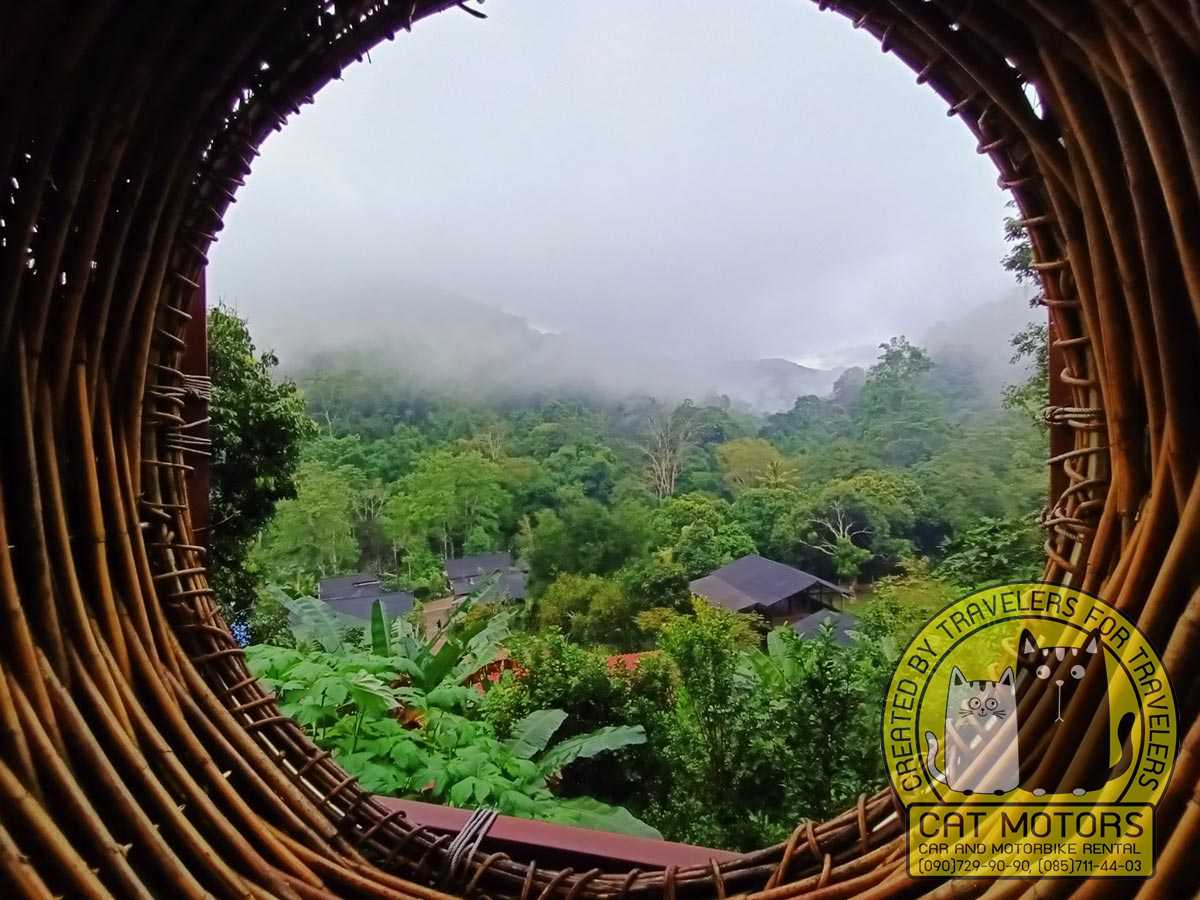
Traveler Tips: It’s best to visit Café In The Doi by motorcycle, as parking for cars can be limited. Mae Kampong has small parking areas that fill up quickly, especially in the morning when people arrive for the Instagram-worthy views. Bring a bottle of water and sunscreen — the morning sun can be deceivingly bright. In summer, go for their icy drinks like bingsu to stay cool, while winter is perfect for a hot cup of tea.
Lung Pud Pa Peng Coffee
Best time: Morning, 8:00 – 10:00
Lung Pud Pa Peng Coffee location
Lung Pud Pa Peng Coffee is arguably the most popular café in Ban Mae Kampong, and for good reason. It’s located right in the heart of the village, offering a colorful backdrop that seems tailor-made for Instagram. The café itself is a two-story wooden house, nestled beside a stream where you can sit and enjoy the gentle flow of water while savoring a slice of cake or a local dish. If you’re lucky enough to grab one of the creekside tables, you’ll be greeted with the soothing sounds of the water and the fragrance of blooming flowers.
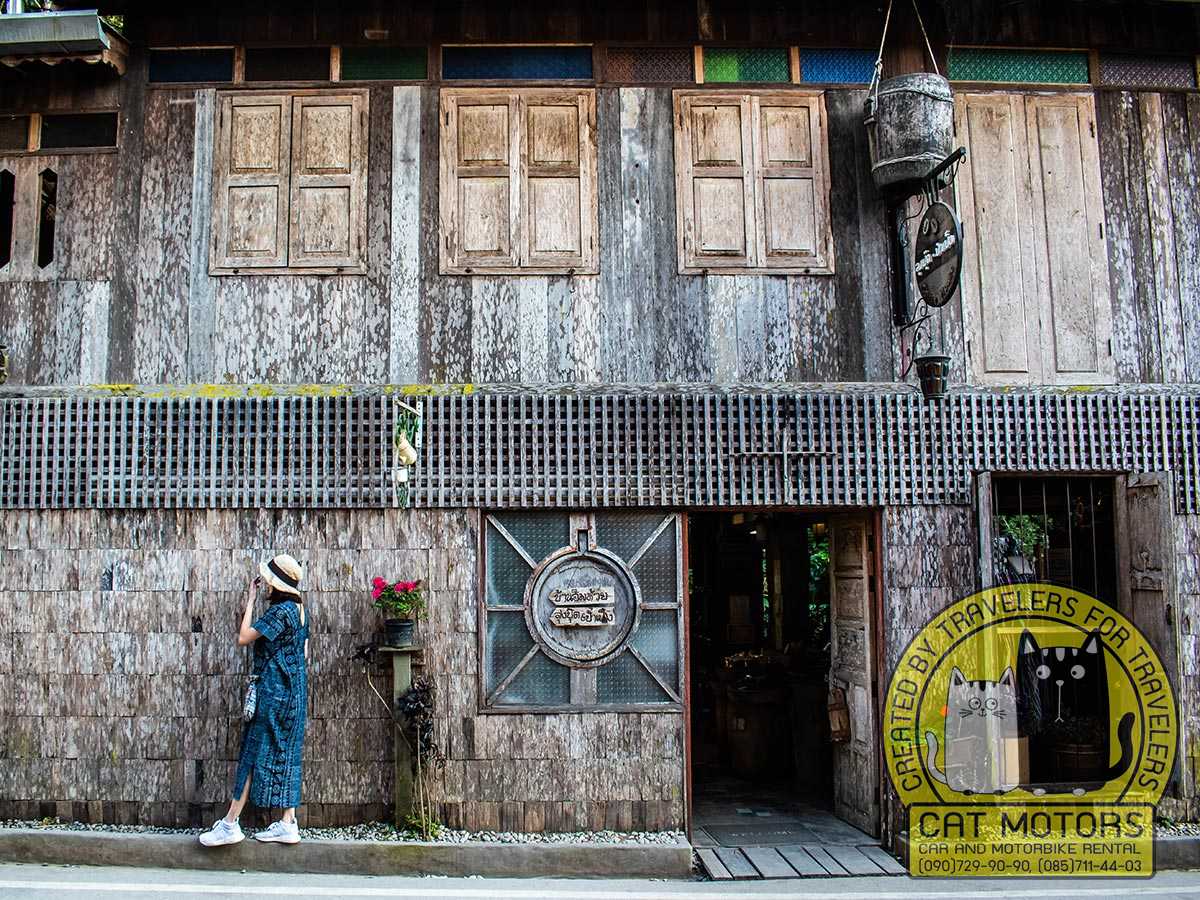
Morning is the perfect time to visit, when the sun begins to rise and the village awakens, the soft mist mixing with the aroma of fresh coffee. This is the kind of place where you can taste the local culture — quite literally. Don’t miss their sai ua — the Northern Thai sausage — grilled right in front of you, infused with fresh herbs like lemongrass, kaffir lime, galangal, and chilies. The result? A burst of flavors that hits every note from spicy to aromatic.
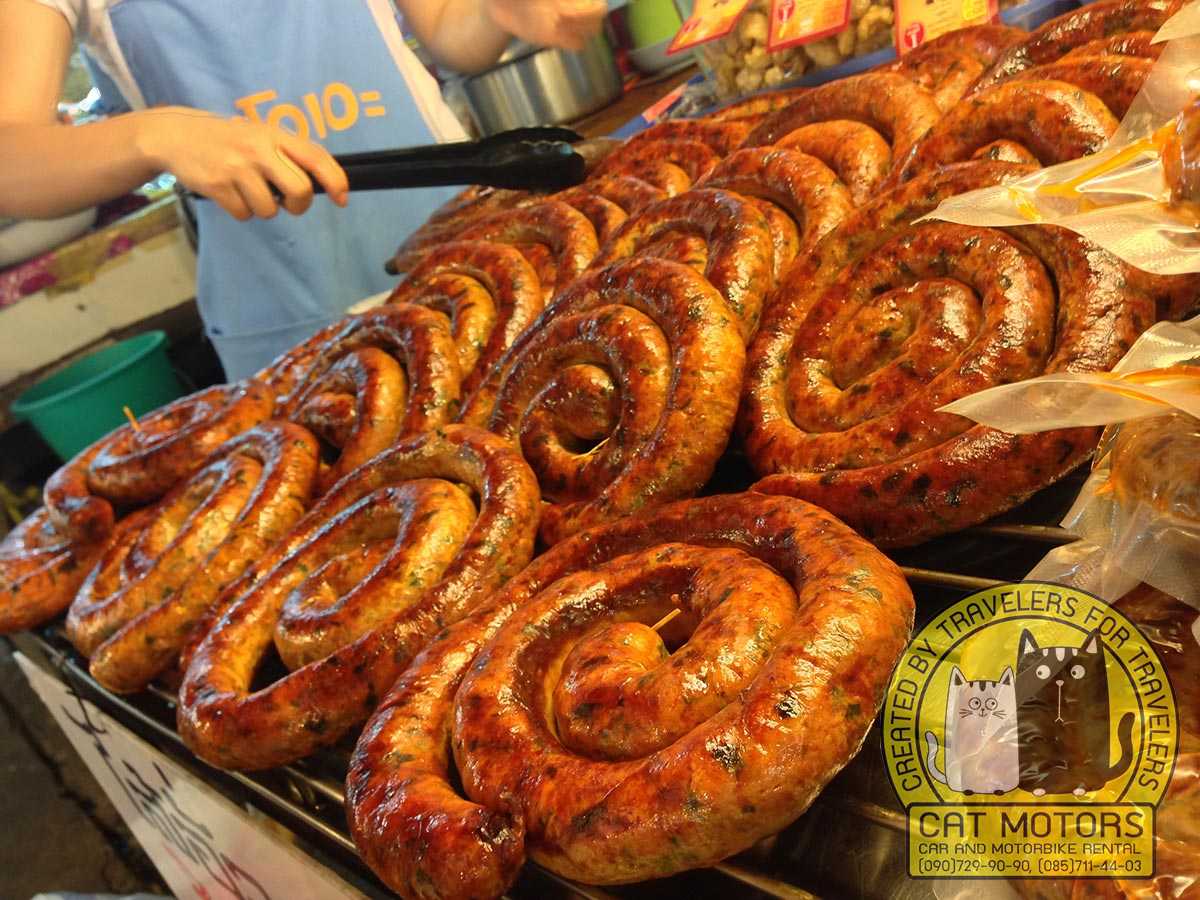
Next door, at Sai-ua Mae Nim (Mom Nim’s sai-ua sausage), you’ll find spicy sausages prepared with authentic northern Thai spices, grilled to perfection right in front of you. These sausages are made with fresh local ingredients like lemongrass, kaffir lime leaves, and galangal, giving them a rich and aromatic flavor. Don’t miss the chance to try them — they’re a true taste of the region, and absolutely delicious!
Traveler Tips: Parking in the center of Mae Kampong can be tricky, especially on weekends and holidays when tourists flock to the village. Arrive early to secure a spot. The best parking options are on the outskirts of the village, from where you can easily walk to all the main attractions. Keep in mind that the roads into the village are narrow and winding, so caution is advised when driving. Also, bring cash as most cafés do not accept credit cards. In winter, a hot herbal tea is a must, while in summer, a cold fresh juice or iced tea will hit the spot.
Pirunya Coffee
Best time: Mid-morning, 9:00 – 11:00
Pirunya Coffee location
Pirunya Coffee is the only place in Mae Kampong where you can enjoy freshly brewed specialty coffees from around the world. This quaint little café offers beans from Brazil, Colombia, Honduras, Guatemala, Indonesia, Vietnam, Tanzania, Ethiopia, Jamaica, Panama, Rwanda, and Bolivia, among others. Set in a rustic house made of simple building blocks, Pirunya surprises you with a wide range of brewing methods, from geyser coffee makers to Viennese siphons, creating a true homebrew lab experience. The atmosphere here is relaxed, perfect for those looking to savor a quality cup of coffee amidst the lush surroundings of Mae Kampong.

Traveler Tips: If you’re a coffee lover, this is a must-visit. Arrive mid-morning to avoid the early rush and have your pick of the best seats. Parking might be limited, so consider leaving your car in the village center and taking a short walk. Try different brewing methods to explore the variety of flavors from various coffee-growing regions.
Teen Tok Royal Project Coffee Shop
Best time: Early or late afternoon, 11:00 – 13:00 or 15:00 – 17:00
The Teen Tok Royal Project Coffee Shop combines the pleasure of freshly brewed coffee with the opportunity to learn about local culture and sustainable agriculture. Set by a serene creek, this open-air café offers a peaceful retreat where you can sit surrounded by greenery, sipping on a cup of aromatic local Arabica while listening to the gentle trickle of the stream. Here, you can try fresh produce from the Royal Project, like salads made with avocado and passion fruit, or traditional dishes featuring locally grown shiitake mushrooms. It’s a perfect spot for those interested in sustainable tourism and wanting to support community initiatives.

This agricultural project was created by His Majesty King Rama 9 in 1981 when His Majesty donated about 300,000 baht of his personal funds to build the Teen Tok Agro-Cultural Research Centre.
In 1981, the average wage for a worker in Thailand was 47 baht a day (USD 2), or 1100 to 1300 baht a month. So the 300,000 baht donated in 1981 is equivalent to about $100,000 today.
In addition to eating or relaxing in nature, you can also explore the local orchid garden. And just a few minutes away, you can enjoy authentic Vietnamese coffee grown and roasted according to Vietnamese tradition at Mon Teen Tok Café.
Traveler Tips: Parking at Teen Tok Royal Project Coffee Shop can be scarce, particularly on weekends. It’s best to visit early or in the late afternoon to avoid the crowds. Consider leaving your car a bit farther away and walking in to enjoy the peaceful surroundings. This is also a great time to explore the nearby plantations and see how coffee and other crops are cultivated.
Teddu Cafe
Best time: Afternoon, 13:00 – 16:00
Teddu Cafe location
Teddu Cafe is nestled in lush greenery right next to a small waterfall. To get there, you’ll need to descend a set of stairs, and just beside the stairs is a bridge that crosses the creek and leads directly to the café. As you cross the bridge, the sound of cascading water grows louder, and soon you’re enveloped by the cool mist from the waterfall.

The café is all about relaxation — picture yourself on the wooden terrace, savoring a piece of honeycomb cheesecake and a freshly brewed coffee, while the calming sound of the waterfall fills the background. The cheesecake is made using local ingredients, and the honeycomb gives it a delightful sweetness and texture that makes it truly unique. Teddu Cafe is a great place to escape the afternoon heat, finding shade under the trees and coolness by the waterfall.
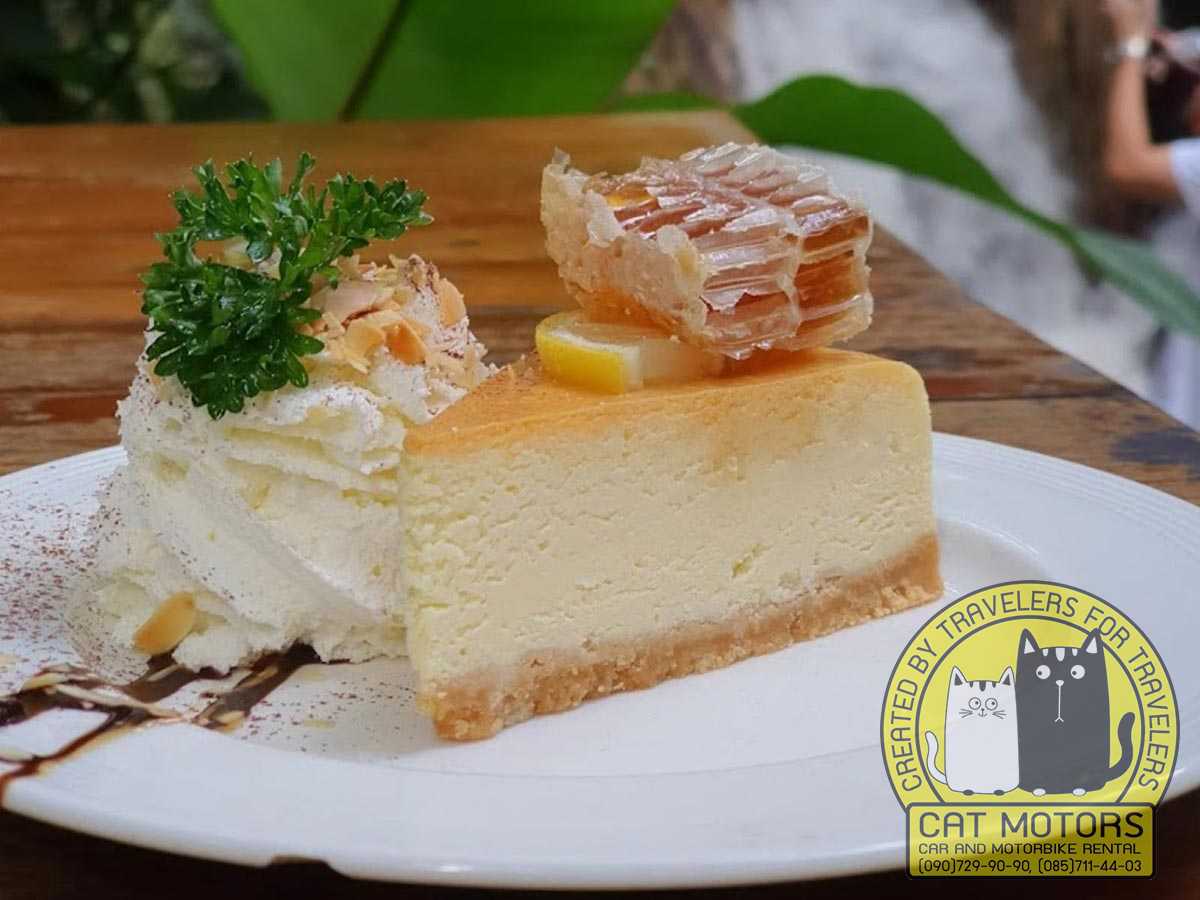
Traveler Tips: Parking near Teddu Cafe is limited, so it’s best to leave your car in the village center and walk. This way, you can also enjoy the natural beauty on the way to the café. Keep in mind that the bridge and stairs can be slippery, especially when wet, so wear appropriate shoes. Insect repellent is also a good idea, as mosquitoes can be present in the shaded areas. On hot summer days, cooling off by the waterfall with a cold drink is a treat, while winter calls for a hot herbal tea as you listen to the soothing water.
Rabeing View Cafe
Best time: Afternoon, 16:00 – 18:00
Location of Rabeing View Cafe
Rabeing View Cafe is the kind of place that makes you slow down and savor every moment — a hidden gem in Mae Kampong that offers an authentic slice of northern Thailand. Perched on a terrace overlooking the village, this café is all about the view. Late afternoon is the best time to visit; the golden light bathes the village below, creating a serene atmosphere that invites you to sit back, relax, and take it all in.

The real star of the menu here is Miang — fermented tea leaves served with ginger, tamarind, toasted coconut, sugar, and peanuts. This traditional Northern Thai delicacy is a burst of flavor that combines tangy, sweet, and savory notes in every bite. It’s not just food; it’s an experience that takes you deeper into the region’s culinary culture. Pair it with a cup of freshly brewed herbal tea to fully embrace the moment. There’s something magical about sitting on the rustic wooden terrace, feeling the breeze, and savoring these local tastes as the sun sets.
The café itself is rustic and charming, with a wooden design that fits perfectly into the natural surroundings. It feels like a place untouched by time, where nature and simplicity come together. Whether you’re here for the food, the view, or just to unwind, Rabeing View Cafe has a way of connecting you to the tranquil spirit of Mae Kampong.
Traveler Tips: Visiting Rabeing View Cafe between 4:00 PM and 6:00 PM gives you the perfect light for photos and a relaxing vibe as the day winds down. Parking in Mae Kampong can be challenging, especially on weekends, so consider parking on the outskirts and taking a short walk through the village — it’s a great way to absorb the local atmosphere. Bring cash, as credit cards are not widely accepted. And above all, don’t leave without trying the Miang. It’s a taste of Mae Kampong you won’t find anywhere else, and it’s best enjoyed slowly, with a view that makes you forget about the rest of the world.
Shopping
Cat Hill Gallery
This charming gallery offers locally crafted souvenirs and artworks that capture the spirit of Mae Kampong. You can find unique pieces inspired by the natural beauty of the village and its surroundings. The gallery also features local artists, making it an ideal place to pick up a one-of-a-kind memento of your trip.
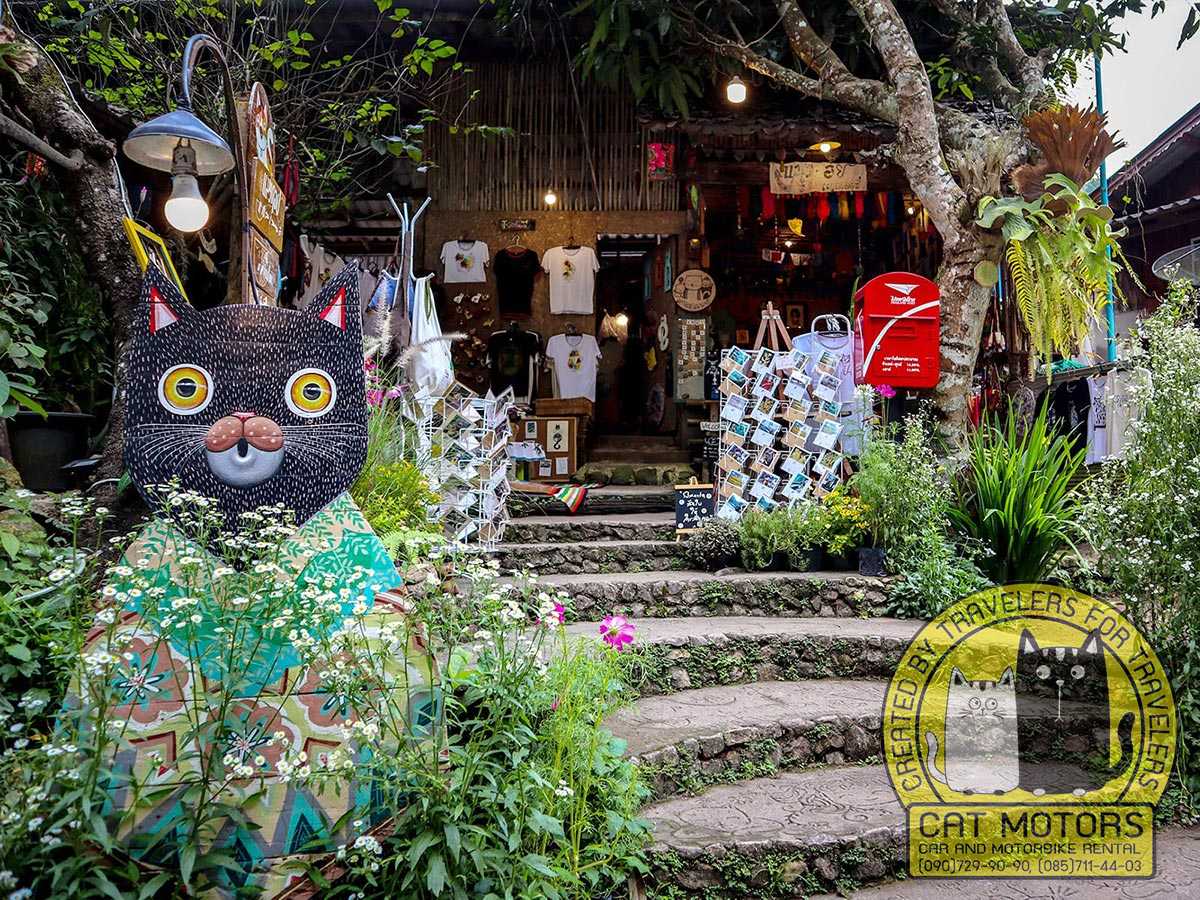
Look out for cat illustrations and cards, cute neckerchiefs, souvenirs, money boxes, key chains, and more! Also, the store is located in a traditional Thai style house, don’t miss it while walking through the village.
Detour
Mueang On Cave
Muang On Cave, formerly known as Tham Doi Sila, is located in Mae On District, Chiang Mai province, and is an easily accessible place. It is about 1 km from the main road (1317) and is a large cave in a limestone mountain surrounded by a mountain range with many stone structures. At the top, a winding staircase leads up to the cave entrance, which then goes down, guiding you to the lower chamber.
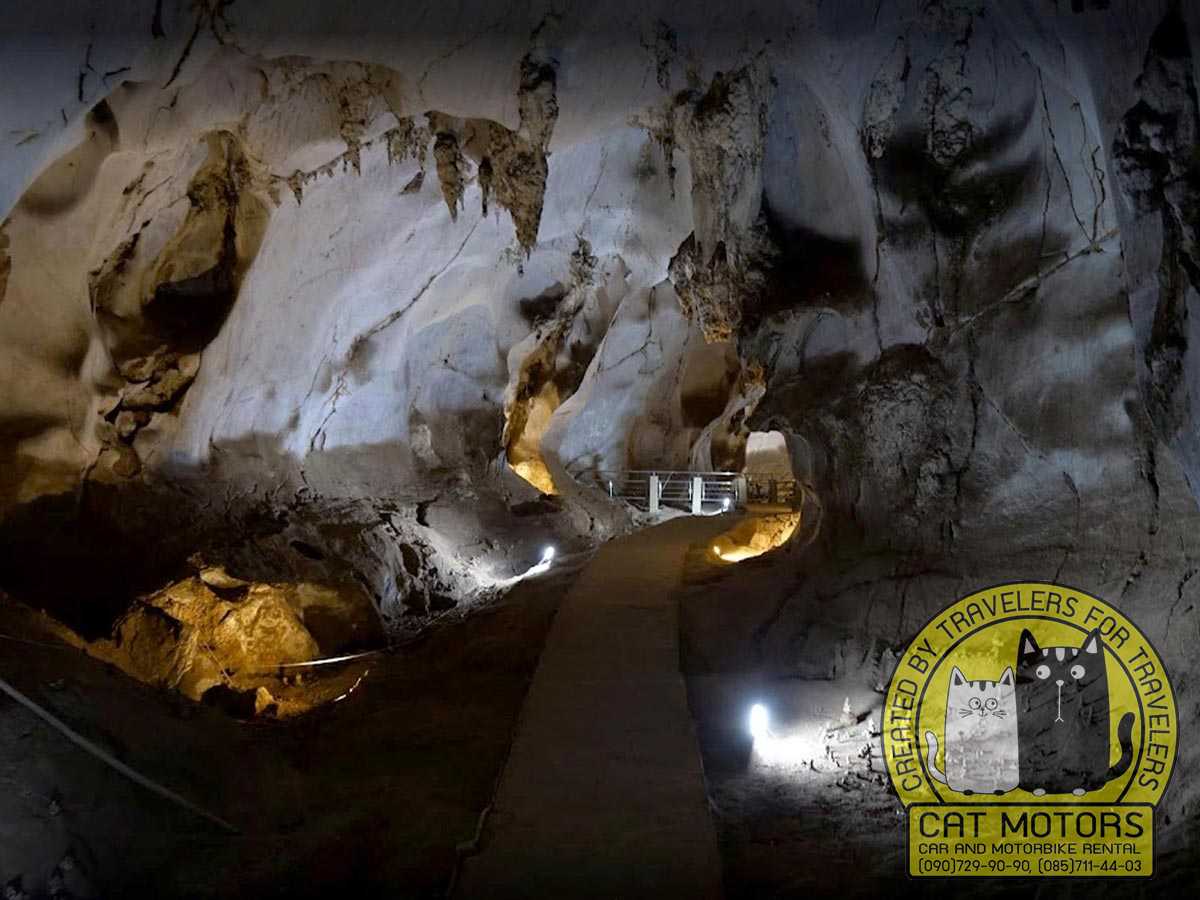
You have to go down about 4-5 floors of cement stairs with handrails (children are allowed, but the elderly or people with bad knees are not allowed). The stairs are pretty steep, and you have to dodge two rocks hanging over your head as you descend. The cave climate is cool and very humid, with water dripping from the vaults in some places. The place is well lit, which is enough to explore the cave about halfway through.
Inside, there are beautiful stalactites and stalagmites. You will find some imaginary figures here, such as seals, five-headed elephants, and dinosaurs. In the center of the cave, there is a Buddhist relic “Phra That Nom Pha” and statues of Buddha.
More than 100 years ago, this was the meditation site of the famous monk Kruba Srivichai, who refurbished the Wat Phra That Doi Suthep and Wat Suan Dok temples in Chiang Mai.

It takes about 30 minutes to walk inside the cave. The exit is where the entrance is.
Crazy Horse Buttress
For adventure enthusiasts, Crazy Horse Buttress is a must-visit destination located near Mae Kampong. It is one of Northern Thailand’s premier rock climbing locations, known for its impressive limestone cliffs and well-maintained climbing routes that cater to all skill levels. Whether you’re an experienced climber or a beginner looking to try something new, Crazy Horse Buttress offers a range of climbing experiences, from easy climbs to challenging overhangs. The area is also popular for caving and rappelling, making it a versatile adventure spot for thrill-seekers.
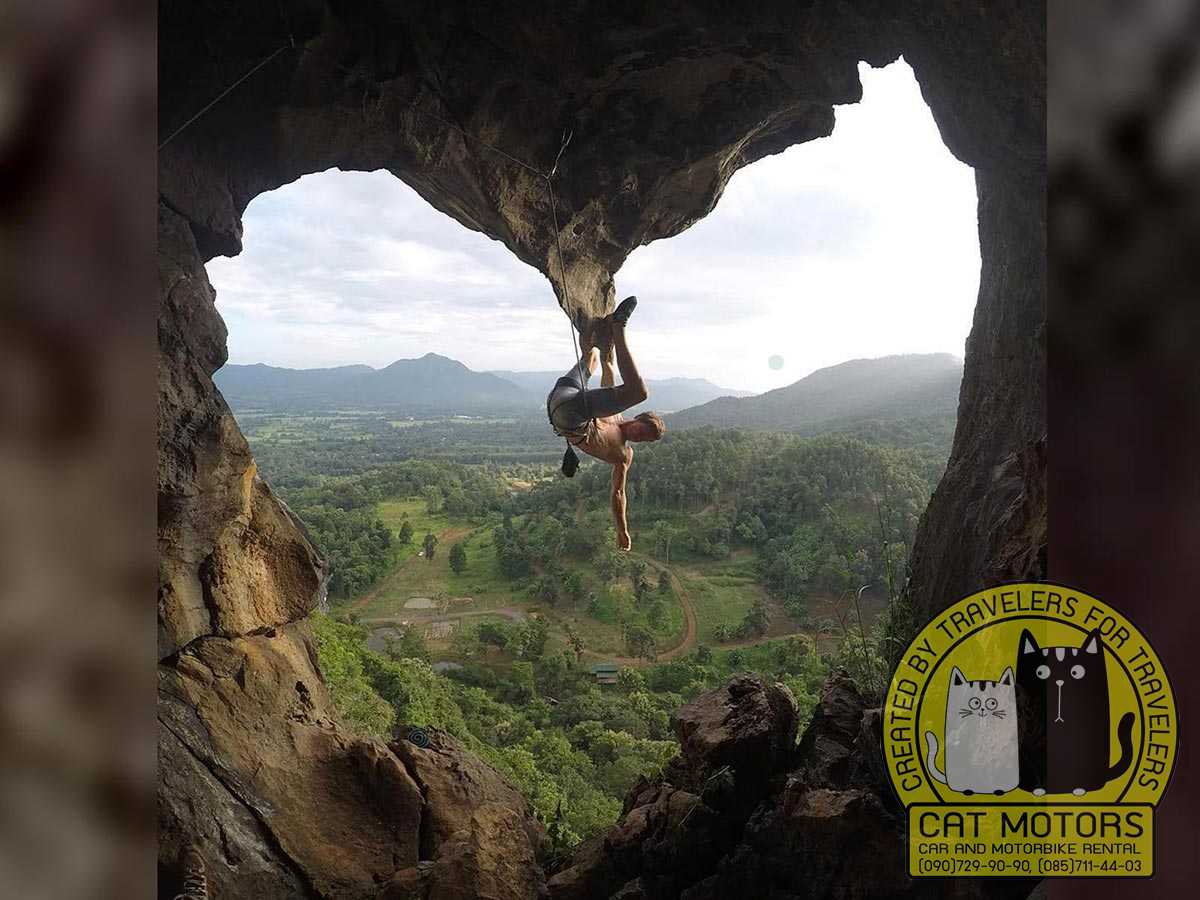
The natural beauty of Crazy Horse Buttress is breathtaking, with lush greenery surrounding the cliffs and providing a serene backdrop. Climbing here is not just about the adrenaline rush; it’s also about connecting with nature and enjoying the spectacular views from the top. Local guides and climbing schools are available if you need assistance or training, ensuring a safe and enjoyable experience.
Traveler Tips: If you plan to visit Crazy Horse Buttress, make sure to bring appropriate climbing gear or check with local climbing schools for rentals. Start early in the morning to avoid the midday heat, and bring plenty of water, as the climb can be physically demanding. Comfortable, sturdy shoes are a must, and insect repellent will come in handy. Even if you’re not into climbing, the area around Crazy Horse Buttress is beautiful for hiking and exploring.
You can climb the rocks on your own (if you have the necessary equipment) or hire a guide to help you during the journey. The difficulty of the routes is from 5a to 8b+.
Hot Springs
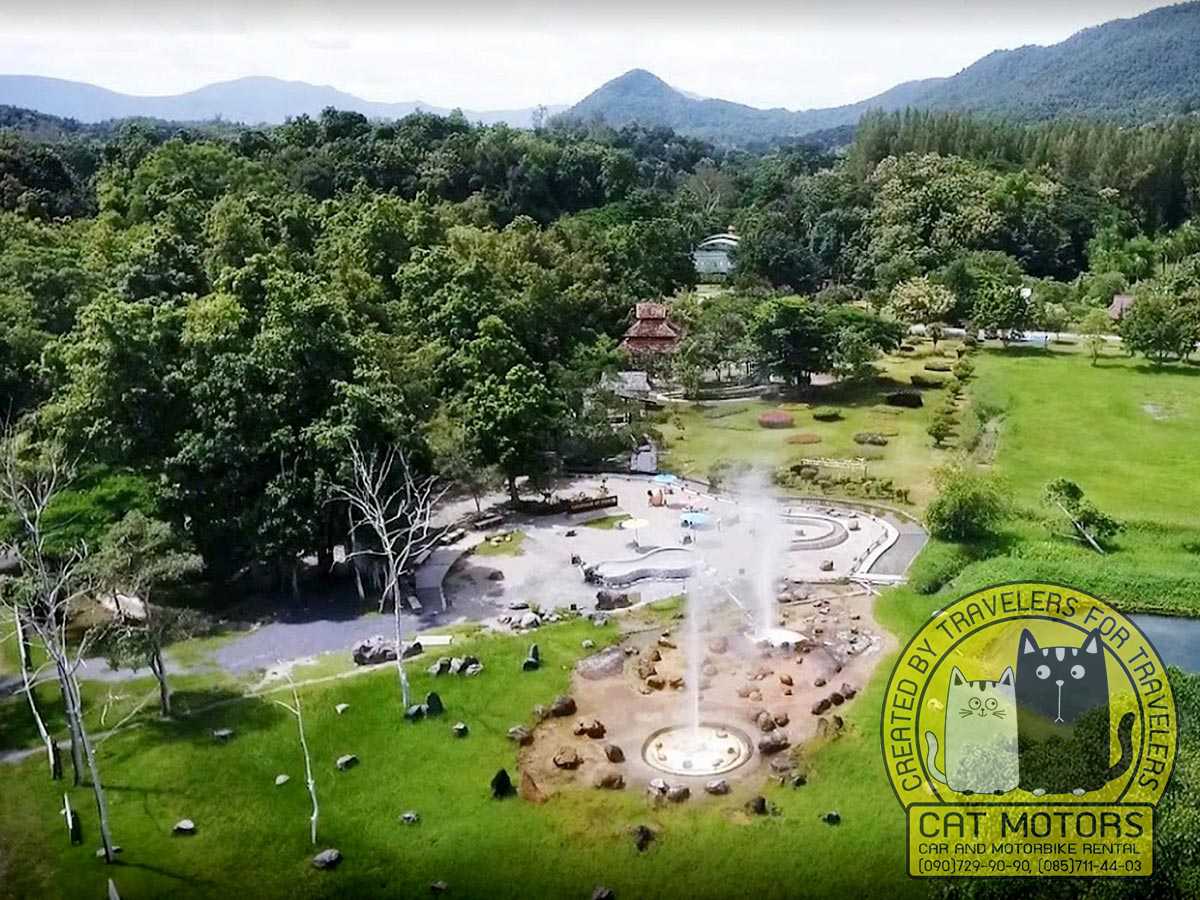
On the way to Mae Kampong, you can visit the natural hot springs at San Kampaeng. This place is well equipped, and here you can boil chicken or quail eggs in natural boiling water, relax and warm your feet in a thermal basin, swim in the covered pool with water from hot springs, and rent a bungalow with a private bath filled with mineral water, and watch the geyser coming out of the ground.
Be careful not to fall into the boiling water. It can be crowded on weekends.
How To Get To Mae Kampong
By car
1. The route from Chiang Mai towards Doi Saket.
If you prefer to rent a car, including the option to return the rental car to a rental location in another city, we recommend that you compare car rental rates in Chiang Mai. Prices may differ by half or more.
Leave the city via Kaew Nawarat road. Then, go straight ahead on road number 118 towards Doi Saket. At the Ban Pong Din checkpoint, turn right onto road number 3005. Then go straight ahead without turning until you come to a rural T-crossroad. At this point, turn left onto road 5080, and in a few minutes, you will be in Mae Kampong. There’s a road sign. You won’t get lost.

2. Route through San Kamphaeng. Is it the most straightforward way if you don’t have a map or GPS. Just keep following the new road to San Kamphaeng (1317) and go to the end until you reach Mae Kampong.
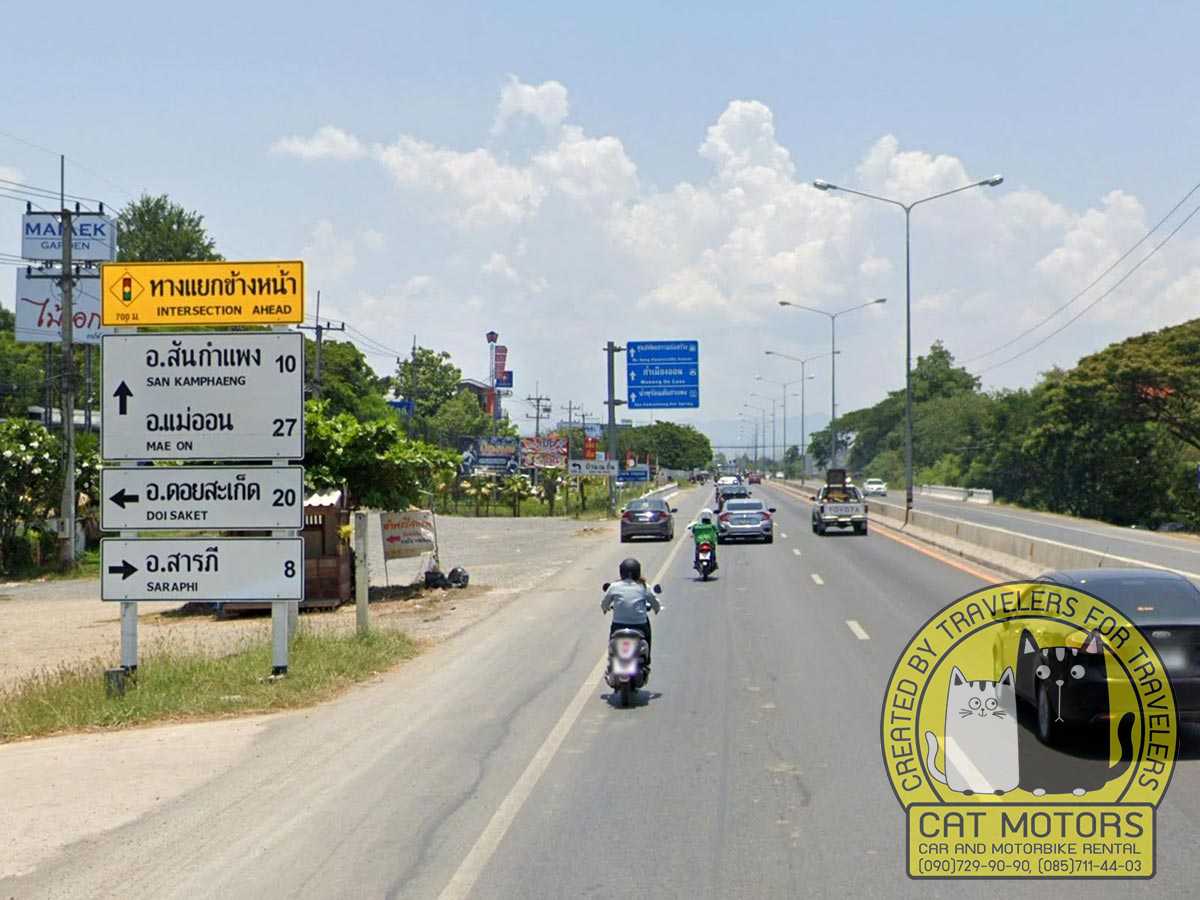
By bus
You can hop on a bus either at the Chang Phueak bus station or at the stop at Wararot Market. It is best to leave Chiang Mai on the first bus at 7:30 am. You will then arrive in Mae Kampong at about 9:20 am, and you will have a full day to rest and see the local sights. The one-way fare (2 hours) is only 150 baht.
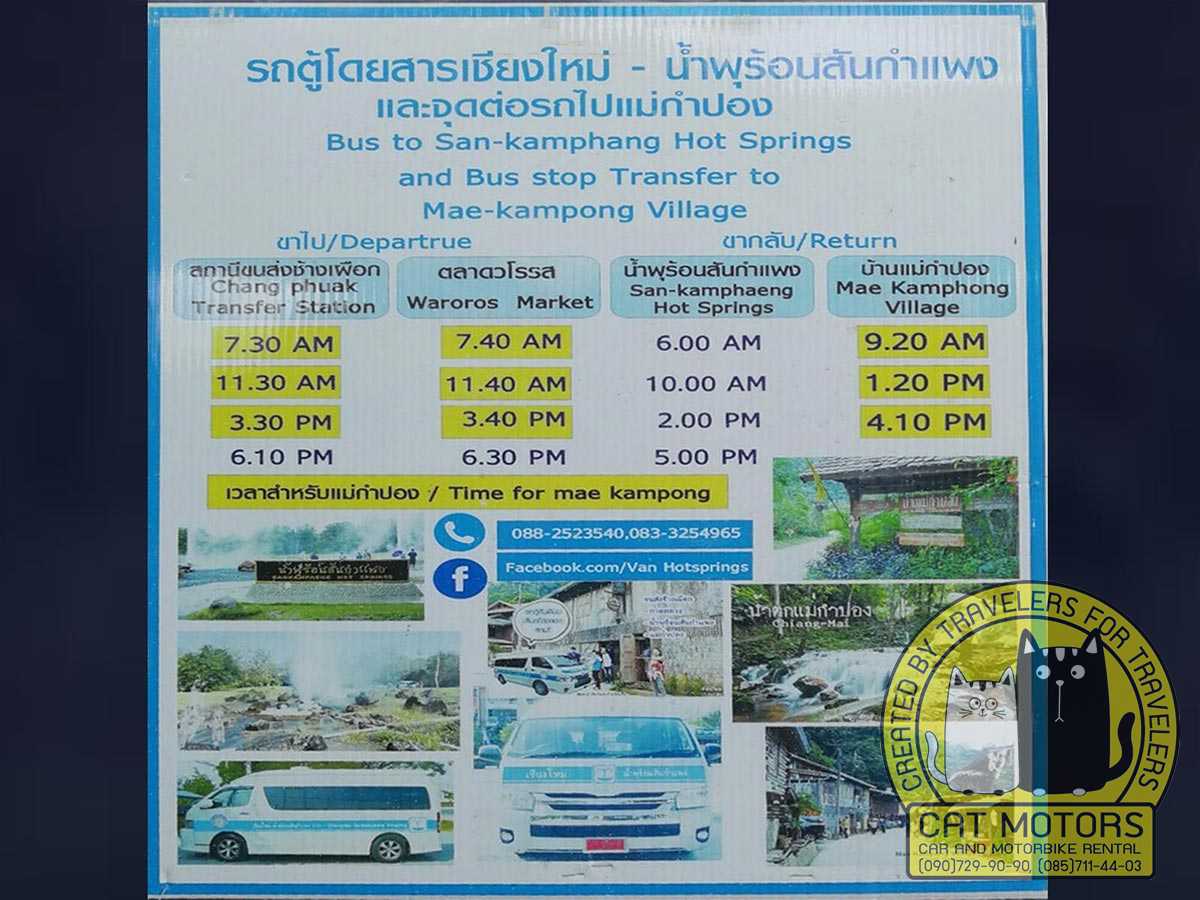
The departure time from Mae Kampong is 09:20, 13:20, and 16:10. The departure stop is right in the schoolyard (Google Map).
Mae Kampong Weather
In our opinion and from our observations, Meteoblue gives the most correct weather forecast for this place.
Quick Facts About Mae Kampong
A Geographic Snapshot
- Location:
- Country: Thailand
- Province: Chiang Mai
- Sub-district: Mae On
- Distance from Chiang Mai City: Approximately 50 kilometers east
- Elevation: Approximately 1,300 meters above sea level
- Population: ~120 families
- Climate: Subtropical Highland
- Language: Thai, with Northern Thai dialect influences
- Currency: Thai Baht (THB)
- Time Zone: Indochina Time (ICT)
History and Culture
- Establishment: Over a century ago
- Original Inhabitants: Settlers from the Tai Yai ethnic group
- Historical Significance: Known for traditional tea cultivation and Miang production
Economy and Livelihood
- Traditional Industries: Tea cultivation, Miang (fermented tea) production
- Current Economic Focus: Sustainable and community-based tourism
Accessibility and Visitor Information
- Nearest Major City: Chiang Mai
- Best Time to Visit: November to February (cool season)
- Visitor Etiquette: Respect local customs, modest dress, environmental consciousness
- Transportation: Accessible by car or motorbike; limited public transport options
Pros & Cons
Traveling to Mae Kampong, like any destination, comes with its own set of advantages and challenges. Here’s a narrative guide to help you weigh the pros and cons:
Pros of Traveling to Mae Kampong
- Cultural Immersion: Mae Kampong offers a deep dive into authentic Thai culture. It’s a haven for those looking to experience traditional Thai village life, from participating in local cooking classes to learning about the unique process of Miang tea production.
- Natural Beauty: The village is a paradise for nature lovers. Nestled in the hills of Chiang Mai Province, it presents lush landscapes, verdant forests, and stunning waterfalls. Hiking through these serene trails can be a rejuvenating experience.
- Cooler Climate: Situated at a higher elevation, Mae Kampong enjoys a cooler climate compared to other parts of Thailand. This makes it a pleasant escape, especially from the heat of the plains.
- Sustainable Tourism: Mae Kampong is an exemplar of sustainable tourism. The community’s effort to preserve their environment and culture while welcoming visitors is both admirable and educational.
- Unique Accommodations: The village offers unique homestay experiences. Staying with a local family provides an intimate look at the day-to-day life in Mae Kampong and supports the local economy.
Cons of Traveling to Mae Kampong:
- Accessibility: Mae Kampong is less accessible compared to more popular tourist destinations. The journey involves a drive through winding hills, which might not suit everyone.
- Limited Amenities: As a small village, Mae Kampong doesn’t have the range of amenities found in larger tourist spots. This includes fewer choices for dining and entertainment.
- Language Barrier: English is not widely spoken here, so communication might be a challenge. This could make navigating and learning about the local culture a bit difficult without a guide or translator.
- Limited Nightlife: If you’re looking for vibrant nightlife, Mae Kampong may not meet your expectations. The village life is quiet and serene, focusing more on cultural experiences and nature.
- Seasonal Weather: During the rainy season, the trails and outdoor activities might be less accessible, and the beauty of the outdoors can be somewhat diminished.
In summary, Mae Kampong is an ideal destination for those seeking cultural richness, natural beauty, and a quiet retreat. However, it might pose challenges for those accustomed to easily accessible tourist destinations with abundant amenities and nightlife. Consider these factors to decide if Mae Kampong aligns with your travel preferences and expectations.
Mae Kampong Village: A Brief Overview
Mae Kampong, a tranquil village 55 km from Chiang Mai, offers a serene escape into Northern Thailand’s countryside. Renowned for its lush tea and coffee plantations, the village provides a picturesque setting perfect for nature lovers. Visitors can enjoy scenic walks through verdant landscapes and visit local attractions such as the beautiful Mae Kampong Waterfall.
In Mae Kampong, travelers can immerse themselves in authentic Thai culture. The village is known for its traditional homestays, where visitors can experience local hospitality and participate in daily activities. This cultural exchange offers a unique insight into the rustic lifestyle of the villagers, making it a memorable part of any trip.
For those seeking adventure, Mae Kampong does not disappoint. Activities like the thrilling Flight of the Gibbon zip-line provide an adrenaline rush amidst the natural beauty. Additionally, tranquil spots like the Rabeing View Cafe offer stunning views and peaceful moments, making Mae Kampong a well-rounded destination for both excitement and relaxation.
Immersive Homestays in Mae Kampong
Mae Kampong is famous for its community-run homestays – rustic wooden houses amid lush forests and flowing streams. Staying with a local family offers an intimate glimpse into village life, with cool mountain air and serene nature as your backdrop. Homestay prices range roughly from 500 to 1,000 THB per night (about USD 15–30), including simple accommodations and often home-cooked meals (prices are approximate and subject to change). Here are a few highly rated and unique options:
Chaiyapol Homestay – Scenic Waterfall Retreat. Perched higher up the hillside, Chaiyapol boasts rooms overlooking a cascading stream. Guests love the large balcony above the waterfall and the comfortable, modern touches in the rustic wooden house. Mornings here are special – the local monk visits for alms, blessing guests after they offer food. Approx. Price: ~800–1,000 THB/night (including a hearty breakfast buffet). What’s special: Waking up to the sound of flowing water and participating in daily village rituals gives an authentic, peaceful experience.
Baan Lung Pud & Pa Peng Homestay – Village Center & Coffee House. This popular homestay – whose name affectionately means Uncle Pud & Aunt Peng’s House – sits by a bubbling creek in the heart of Mae Kampong. The wooden rooms are simple yet cozy, surrounded by green mossy trees for a cool, shady ambiance. There’s an attached coffee house that has become a must-visit spot – visitors flock here for photos on the terrace overlooking the river. Approx. Price: ~600–700 THB per person including breakfast (around 1,200–1,400 THB for two). What’s special: Warm “family-like” hospitality and the on-site Lung Pud Pa Peng Coffee House, known for its great coffee and garden setting. You get to stay right where day-trippers stop for the view, enjoying it all after the crowds have left.
Chom Nok Chom Mai Homestay – Panoramic Hilltop View. Meaning “Bird Watching, Tree Watching,” this homestay sits on a hilltop, offering a 180° panorama of Mae Kampong village below. Guests can relax on a terrace hammock with sweeping valley views, literally above the treetops. A charming cafe is attached, serving fresh brews and pastries to enjoy with the scenery. Approx. Price: ~800 THB/night (varies by room). What’s special: Arguably the best viewpoint in the village – sunrise mist and sunset colors are magical from here. Despite its lofty perch, the atmosphere is homey and welcoming, making it a perfect mix of comfort and wow-factor.
Traditional wooden homestays nestle along Mae Kampong’s stream and hillsides. Many are family-run and include meals, so you’ll dine on organic local dishes and even learn to cook Northern Thai recipes with your hosts. The homestay experience is deeply immersive – think helping roast coffee beans in the morning or joining in the fermenting of tea leaves, known locally as miang. Language is seldom a barrier; the genuine warmth and hospitality of Mae Kampong’s villagers transcend words, making your stay both comfortable and culturally enriching
YT Video Review
Thomas, SuperGenki
The Restless Chinchilla
Nin is Cooking VLOG
FAQ
Mae Kampong can be reached by motorcycle or by car. At our company you can rent a motorcycle in Chiang Mai. If you want to rent a car, we recommend EconomyBookings or RentalCars, which compare prices at all major city car rental shops and find the best price for you.
If you want to rent a private car with driver, in which case it will cost you about 1100-1500 baht for a comfortable private minibus.
You can also use public transportation and buy tickets to go to Mae Kampong on a 14 passenger minibus with other tourists, which leaves from the Wararot market. The ticket costs 120-150 baht per person.
Mae Kampong is a village in Thailand known for its sustainable eco-tourism. The village is located in the mountains of Chiang Mai province, and is home to a variety of flora and fauna, as well as a waterfalls and hiking trails. The village is also known for its traditional culture and way of life, with locals living off the land and practicing traditional farming techniques. Also, the Flying Gibbon rope park is located here.
Absolutely! Mae Kampong is a beautiful village with plenty of natural beauty and traditional culture to explore. It is a great place to relax and get away from the hustle and bustle of city life. Additionally, there are plenty of activities to keep you busy, such as hiking, visiting waterfalls, and exploring the Flying Gibbon rope park.
Mae Kampong is on the outskirts of Chiang Mai, about 55 kilometers from the city. The road leading here is well paved, so it is equally easy to get here by car or motorcycle and by bicycle.
There is also public transport, but public transport can sometimes be difficult for foreign tourists because not every driver knows English, and therefore there is a possibility of a language barrier.
The amount of time you spend in Mae Kampong depends on your interests and the activities you plan to do. Generally, two to three days is enough time to explore the village, hike the trails, and visit the waterfall and a viewpoint. However, if you plan to stay longer and explore the area more thoroughly, then four to five days is recommended.
Yes, Mae Kampong is a very walkable village. Most of the village is accessible on foot, and there are plenty of hiking trails and pathways to explore. Additionally, there are a few roads that are suitable for biking.
Mae Kampong is a great place to live if you are looking for a peaceful and sustainable lifestyle. The village is surrounded by beautiful nature, and the locals are very friendly and welcoming.
The rainy season in Mae Kampong typically runs from May to September. During this time, the area experiences a lot of rain and can be quite humid. It is best to avoid visiting during this time if possible.
The hot season in Mae Kampong typically runs from March to May. During this time, temperatures can reach up to 35°C (95°F) and the humidity can be quite high. It is best to bring plenty of sunscreen and water when visiting during this time.
The smog season in Mae Kampong typically runs from March to April. During this time, the air quality can be quite poor due to the burning of agricultural fields in the area. It is best to avoid visiting during this time if possible.
The best time to visit Mae Kampong is from October to February, when the weather is cooler and the air quality is better. Additionally, this is when the area experiences the least amount of rain.
Dive into the heart of Northern Thailand with our expertly crafted travel guides. They highlight the best routes and hidden gems of the region. For those eager to begin, our bike rentals in Chiang Mai home page offers great options. Before you hit the road, please take a moment to read through our terms and conditions. With this knowledge, you’ll be well-equipped to explore the lush scenery and cultural spots that make this area so special. From the mountains to the markets, experience all the wonders Northern Thailand has to offer.
For additional insights, explore our advice sections which offer tips on safety, road conditions, and local etiquette. These guides provide a deeper understanding of the area, helping you to connect more with the local culture and ensuring a smoother, more enjoyable ride.
Cat Motors Team
Was this post useful for you?
You can rate it by clicking on a star
Average rating / 5. Vote count:
No votes so far! Be the first to rate this post.
We are sorry that this post was not useful for you!
Let us improve this post!
Tell us how we can improve this post?
- Author: Natcha Lindberg
- Updated: June 29, 2025
- 2 Comments


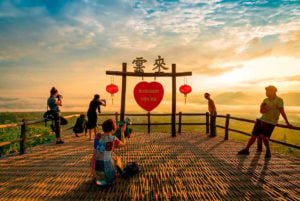

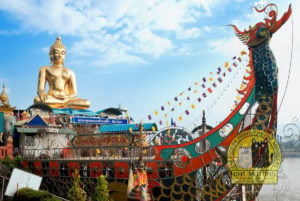
2 Comments
I don’t believe the weather in Mae Kampong is “cool.” At this tropical latitude, you would have to climb above 5,000 feet to see any reduction in the stifling heat and humidity. In the room, in one of the video reviews, there is a mosquito net on the bed. If you go above 5,000 feet above sea level, where the weather is cool, there are no mosquitoes. Check to see if there is air conditioning in any place you visit. Air conditioning = hot weather.
Sorry, but I don’t quite know what you mean when you write that you “don’t believe the weather is cool”.
Right now in Chiang Mai +36C, while in Mae Kampong it’s only +23C. It feels like a huge difference. At night, in December-January, the temperature here drops below +10C. For Thailand, where the average daytime temperature is almost always above +30C is very tangible.
Air conditioners in Thailand are used not only for cooling the air but also for dehumidification. In addition, there are also air conditioners with the function of heating the room.
Also, latitude and longitude do not matter because climate zones are never defined by latitude or longitude, or by parallels or meridians, especially in mountainous areas. Open a climate map of the world, and see what it looks like.
Moreover, the primary condition for mosquitoes to exist is not 5,000 feet above sea level but the presence of standing water where female mosquitoes can lay their eggs. For example, visit Doi Inthanon, whose summit is at 8,400 feet. There are always mosquitoes in the evening because there are several waterfalls with natural pools of standing water. Mae Kampong also has places with standing water because a mountain stream flows along the village. Therefore, it is not surprising that there are mosquitoes here as well.